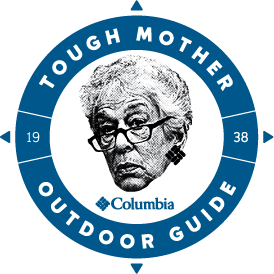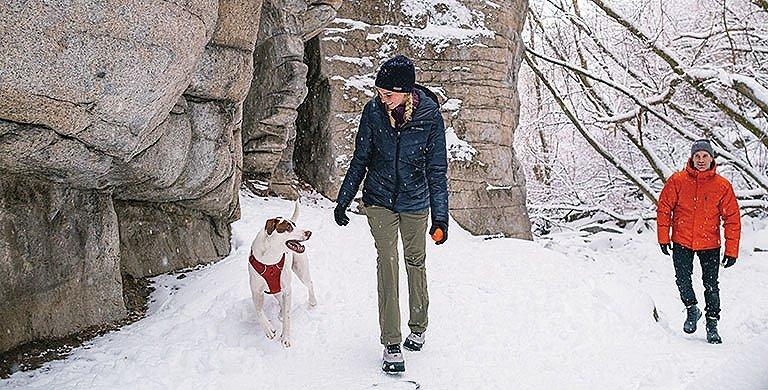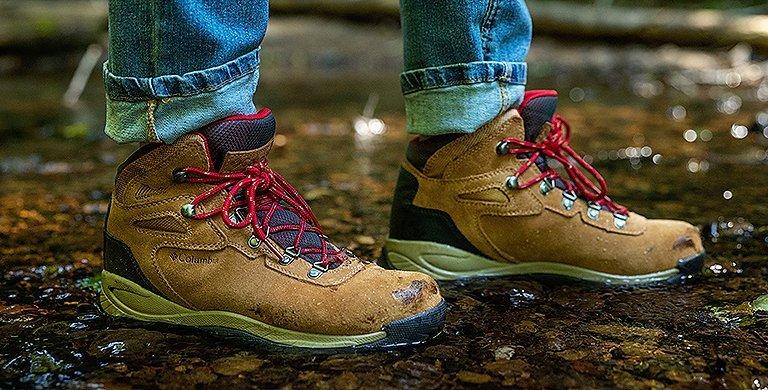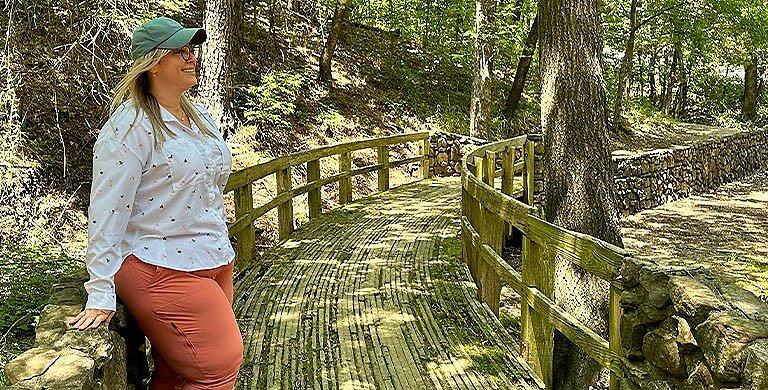HIKING
How to Hike at Elevation
Read our guide for the best tips and advice for hiking at high altitudes
BY KRISTEN GILL
The thrill of conquering challenging trails, overcoming altitude-related obstacles, and witnessing the world from a different perspective makes high elevation hiking an unforgettable and enriching adventure. It’s challenging both physically and mentally—an exhilarating experience that pays off with breathtaking vistas, crisp mountain air, and immersion in the untamed beauty of nature.
To learn more about how to hike at elevation, we reached out to Linda Black Regnier, avid hiker, climber, and author of “Best Easy Day Hikes Santa Fe.” Regnier boasts extensive experience hiking at high elevations, including Nepal’s Kala Patthar above Everest Base Camp (18,519 feet) and several peaks in New Mexico’s Sangre de Cristo mountains (above 12,500 feet).
To learn more about how to hike at elevation, we reached out to Linda Black Regnier, avid hiker, climber, and author of “Best Easy Day Hikes Santa Fe.” Regnier boasts extensive experience hiking at high elevations, including Nepal’s Kala Patthar above Everest Base Camp (18,519 feet) and several peaks in New Mexico’s Sangre de Cristo mountains (above 12,500 feet).
Hiking expert Linda Black Regnier, pictured above on Montana’s Mt. Aeneas Summit Trail, explains that the atmosphere begins to change around 7,000 feet, where pressure drops and oxygen levels start to decrease rapidly.
What is considered high elevation for hiking?
The atmosphere begins to change around 7,000 feet, which is where the percentage of oxygen starts to decrease rapidly. Regnier explains that by 8,000 feet, significant changes in vegetation, tree line, wildlife, and impact on the human body occur. Mountaineering organizations often break high elevation hiking into three categories:
- High altitude: 7,000 to 11,500 feet
- Very high altitude: 11,500 to 18,000 feet
- Extremely high altitude: above 18,000 feet
What’s the difference between elevation and altitude?
The primary distinction between altitude and elevation is that altitude describes the vertical distance between an object and a reference point, whereas elevation describes the height of a location above sea level. However, practically speaking, the terms are often used interchangeably among hikers.
Is hiking at high elevations harder?
Hiking at high elevations is indeed harder, explains Regnier, due to a decreased amount of oxygen and atmospheric pressure. But as long as hikers are safe and prepared, that shouldn’t deter them from this fun and rewarding experience.
Trail conditions can be challenging at higher elevations, which are often steeper and rockier with features like loose scree, boulders, and rocky outcrops. It is essential to have hiking boots with excellent traction such as the Facet™ 75 Alpha, pictured above.
What should you pack for high elevation hikes?
How much gear you pack for a high-elevation hike depends on the time of year and what season it is, Regnier explains. “Knowing how to layer is important, as temps and conditions fluctuate a lot. I always make sure to have a baselayer, a fleece, and a vest. And of course a jacket.” In extra cold climates, midlayers with technologies like Omni-Heat™ Helix will keep you the warmest.
“You always want to have a hat with a wide brim,” says Regnier. She also recommends a good backpack, sunglasses with UV protection, and good lip balm. Hiking shirts and pants with UPF-rated fabric work great and can be even more effective than sunscreen because you don’t have to keep reapplying it. Just make sure that you still use sunscreen on your face, ears, neck, hands, and other uncovered areas.
Choose hiking gear with sweat-wicking fabrics instead of cotton to provide moisture management. Regnier prefers leggings to hiking pants, but notes that it’s a matter of personal preference. She also recommends hiking poles for anyone with knee issues to lessen the pressure on them.
“It's typically steeper, and at a lot of really high elevations you're above the tree line, so you might have to ditch your poles if you have to scramble,” says Regnier. “But until you get to that point, they're very handy. You can always stash them somewhere and get them on the way back down.”
Rainwear is critical and needs to be not only fully waterproof at high elevations, but lightweight, breathable, and packable. This is especially important if you’re hiking somewhere that has a monsoon season, when heavy rain can come on rapidly. Choose something with advanced waterproofing features such as OutDry™ Extreme.
“In New Mexico, I've been caught in horrific rainstorms, where I’ve gone out in the morning and it was beautiful and sunny, and then suddenly a monsoon rolls in,” says Regnier.
Lastly, it is imperative to have proper footwear. “Above the tree line, it’s really important to keep in mind that you usually don't have very good trails. So you really need rugged, high-quality shoes,” she says. Look for options with sturdy ankle support and exceptional traction such as the Facet™ 75 Alpha or anything with Adapt Trax™ technology. Higher tops are important too, so you may want to opt for hiking boots over hiking shoes at higher elevations.
Here’s a checklist of some basic high elevation hiking gear to consider:
“You always want to have a hat with a wide brim,” says Regnier. She also recommends a good backpack, sunglasses with UV protection, and good lip balm. Hiking shirts and pants with UPF-rated fabric work great and can be even more effective than sunscreen because you don’t have to keep reapplying it. Just make sure that you still use sunscreen on your face, ears, neck, hands, and other uncovered areas.
Choose hiking gear with sweat-wicking fabrics instead of cotton to provide moisture management. Regnier prefers leggings to hiking pants, but notes that it’s a matter of personal preference. She also recommends hiking poles for anyone with knee issues to lessen the pressure on them.
“It's typically steeper, and at a lot of really high elevations you're above the tree line, so you might have to ditch your poles if you have to scramble,” says Regnier. “But until you get to that point, they're very handy. You can always stash them somewhere and get them on the way back down.”
Rainwear is critical and needs to be not only fully waterproof at high elevations, but lightweight, breathable, and packable. This is especially important if you’re hiking somewhere that has a monsoon season, when heavy rain can come on rapidly. Choose something with advanced waterproofing features such as OutDry™ Extreme.
“In New Mexico, I've been caught in horrific rainstorms, where I’ve gone out in the morning and it was beautiful and sunny, and then suddenly a monsoon rolls in,” says Regnier.
Lastly, it is imperative to have proper footwear. “Above the tree line, it’s really important to keep in mind that you usually don't have very good trails. So you really need rugged, high-quality shoes,” she says. Look for options with sturdy ankle support and exceptional traction such as the Facet™ 75 Alpha or anything with Adapt Trax™ technology. Higher tops are important too, so you may want to opt for hiking boots over hiking shoes at higher elevations.
Here’s a checklist of some basic high elevation hiking gear to consider:
Sun exposure, dehydration, inclement weather, unimproved trails, and lack of oxygen are all factors that make it essential to be prepared with proper gear when hiking at high elevations.
Things to consider when hiking at high elevation
It takes more preparation, planning, and conditioning to hike at higher elevations than other hikes. This is crucial because as you ascend, the air becomes thinner, making physical fitness and acclimatization essential for a safe and enjoyable experience. Here are some factors to keep in mind:
1. Exposure
The sun poses a greater risk at higher elevations, so it’s extra important to plan for safe sun exposure. Wear UPF-rated clothing and minimize any amount of exposed skin as you hike. Regnier explains, “At higher elevations, the environment is much more intense, so you have to be careful to drink more water and use sunscreen. Every thousand feet that you go up, the UV rays increase by 10%.”
2. Dehydration
Staying hydrated is essential during higher altitude hikes due to increased fluid loss through respiration and perspiration, as well as the risk of dehydration from dry mountain air. To ensure proper hydration, hikers should drink more water than usual, even if they don't feel excessively thirsty. A general guideline is to aim for at least two to three liters of water per day. Carry a reusable water bottle or hydration bladder, and take regular sips throughout the hike to maintain hydration levels. Additionally, alcohol should be avoided as well as excessive caffeine consumption as they can contribute to dehydration.
3. Weather conditions
As you climb up, atmospheric conditions shift, leading to greater temperature fluctuations and the potential for extreme weather events. “Weather conditions can change so quickly when you’re on a mountaintop,” Regnier explains. “You've got to be prepared for that.” This is especially true between 8,000 and 9,000 feet, she notes. During the daytime, the sun at high altitudes can cause hot conditions, so wear lightweight, breathable clothes with sun protection. Conversely, higher elevations can also experience sudden drops in temperature, so you want to be prepared for that as well. Dress in layers and carry appropriate gear (including insulated clothing and warm midlayers). You might find yourself hiking in the rain or camping in the snow, so check weather forecasts before your hike, bring waterproof gear, and have a plan in place to seek shelter if needed.
Symptoms of altitude sickness can range from mild, including headache, dizziness, nausea, and fatigue, to severe symptoms that involve difficulty breathing, confusion, and life-threatening fluid buildup in the lungs or brain.
4. Trail conditions
Trail conditions and terrain can change significantly as you climb to higher elevations, presenting unique challenges for hikers. Initially, you might encounter well-maintained dirt trails, but as you gain altitude, the path can become steeper and rockier. Loose scree, a mixture of gravel and small rocks, can be common on higher elevation trails, making footing unstable and demanding cautious steps. Boulders and rocky outcrops may require scrambling or even climbing, adding a level of technical difficulty to the hike. Some sections may involve crossing snowfields or glaciers, depending on the season and location. Wearing high-quality footwear is essential.
5. Lack of oxygen
It is harder to breathe at higher elevations because the air pressure decreases, leading to lower atmospheric pressure. As a result, the number of oxygen molecules in each breath decreases, even though the percentage of oxygen in the air remains the same (around 21%). This reduction in available oxygen can make it harder for the lungs to extract the required amount of oxygen from each breath, leading to a condition called hypoxia. To compensate for the reduced oxygen, the body naturally increases the respiratory rate, causing individuals to breathe deeper and faster.
Breathing at high altitude can impact your physical performance and stamina—hiking becomes more challenging, and even simple tasks can feel exhausting. Hikers may find themselves taking more frequent breaks to catch their breath. This can lead to altitude sickness, which can be very serious.
Breathing at high altitude can impact your physical performance and stamina—hiking becomes more challenging, and even simple tasks can feel exhausting. Hikers may find themselves taking more frequent breaks to catch their breath. This can lead to altitude sickness, which can be very serious.
Signs of altitude sickness?
Altitude sickness, also known as acute mountain sickness (AMS), can occur due to the body's struggle to adapt to the high altitude effects of reduced oxygen levels. “About 8,000 feet is the most common altitude where people start feeling mild high altitude sickness,” says Regnier.
Altitude sickness can strike anyone regardless of age or physical fitness, so it's essential for hikers and mountaineers to acclimatize gradually, allowing the body time to adjust to the changing conditions.
Failing to acclimate properly or ascending too rapidly significantly increases the risk of altitude sickness, making it crucial to monitor symptoms and descend immediately if severe signs of AMS appear. Proper planning and awareness of altitude-related risks are essential to mitigate the potentially serious consequences of altitude sickness during high altitude adventures.
Altitude sickness can strike anyone regardless of age or physical fitness, so it's essential for hikers and mountaineers to acclimatize gradually, allowing the body time to adjust to the changing conditions.
Failing to acclimate properly or ascending too rapidly significantly increases the risk of altitude sickness, making it crucial to monitor symptoms and descend immediately if severe signs of AMS appear. Proper planning and awareness of altitude-related risks are essential to mitigate the potentially serious consequences of altitude sickness during high altitude adventures.
Signs of sickness
- Mild Mild side effects of high altitude include headache, dizziness, nausea, vomiting, trouble sleeping, and fatigue. “If you experience any of those symptoms, you should take it easy,” Regnier says. “If you're camping, don’t go up any higher. If it starts to get more serious, you may have to descend to a lower elevation.”
- Moderate Moderate high elevation effects include more severe headache, ataxia (poor coordination), disorientation, increased weakness, and more severe nausea and vomiting. With these symptoms, it’s important to descend and not just stay where you are. “If you have symptoms of moderate high altitude sickness, you need to sleep lower than where you were hiking,” she says. “In those cases, you have to go down. I saw this happen when I was hiking toward Everest Base Camp. A fellow in our group got sick. The guide made him go down 500 feet and sleep there for two nights.”
- Severe Severe symptoms of high altitude sickness include difficulty breathing, confusion, and fluid buildup in the lungs or brain (pulmonary or cerebral edema), which can be life-threatening.
At what elevation do you need oxygen?
The need for supplemental oxygen during high altitude hiking can vary depending on individual factors, but generally, it becomes more critical at elevations above 8,000 feet. At this altitude, the air pressure and oxygen levels decrease significantly, leading to reduced oxygen saturation in the blood and potential symptoms of altitude sickness. For extreme high altitude climbs, supplemental oxygen is often used above 26,247 feet to support climbers in the thin air. However, the specific elevation at which supplemental oxygen becomes necessary may vary based on a person's acclimatization, fitness level, and medical condition.
Nepal’s famous Everest Base Camp trek is one of many high altitude trails that Regnier has completed as an avid hiker and outdoorswoman. Above, she is pictured outside Ama Dablam Lodge with her husband Jim.
How to breathe at high altitudes
Breathing techniques are crucial for managing the challenges of high altitudes and ensuring a safer and more enjoyable hiking experience. To cope with reduced oxygen levels, focus on slow and deep breathing, using your diaphragm to maximize the amount of oxygen you take in with each breath. Avoid rapid or shallow breathing, as it can lead to hyperventilation and worsen altitude-related symptoms. Additionally, maintain a steady pace while hiking, allowing your body to adapt gradually to the changing altitude. If you feel breathless or fatigued, take short breaks to catch your breath and rest. Practicing controlled breathing techniques, such as pursed-lip breathing, can also be beneficial in managing breathing difficulties.
It's crucial to listen to your body, pay attention to any signs of altitude sickness, and descend immediately if symptoms become severe. Proper acclimatization, hydration, and gradual ascent are essential elements to support your body's adaptation to higher elevations.
It's crucial to listen to your body, pay attention to any signs of altitude sickness, and descend immediately if symptoms become severe. Proper acclimatization, hydration, and gradual ascent are essential elements to support your body's adaptation to higher elevations.
How to prepare for high altitude hiking
To prepare for high altitude hiking, it is imperative that you acclimate gradually to the higher elevation to allow your body to adapt to the reduced oxygen levels. Start by spending a few days at intermediate altitudes to help your body adjust. If you are planning a trip to a different state, region, or country, you need to build a few extra days into your trip to have time for that acclimatization—use the time to break in your hiking boots.
“If you live at sea level, you can’t fly into Santa Fe where it’s 7,000 feet and decide you're going to go hiking that day. That's a bad idea. You need to prepare yourself. You should acclimate for two or three days, drink lots of water, avoid alcohol, and be sure you eat,” says Regnier.
Prior to your trip, train for your high elevation hike by getting regular cardiovascular exercise—this will improve your lung capacity and physical fitness. Stay well hydrated throughout your preparation and the hike itself, as dehydration can worsen altitude-related symptoms.
Be sure to familiarize yourself with the signs of altitude sickness and be ready to descend if necessary. Adequate rest and sleep are also vital for the body to adapt effectively to the new altitude.
“It doesn't matter if you've spent time in high altitudes before. Even if you have, you can still get sick. You just don’t know,” says Regnier.
She notes that, generally speaking, you should be in good physical condition to attempt higher elevation hikes. When planning your high altitude hike, you should always consult with your doctor, who can prescribe treatment options for altitude sickness in the event over-the-counter medications may not be sufficient.
Regnier also notes that you should never hike alone above 7,000 feet, and should always tell somebody where you're going.
“You can hurt yourself so much more easily at higher elevations. Even if you're in great shape, you can twist your leg when you're crossing a creek, or break an ankle. Plus, you need someone to be there if you start experiencing any high altitude issues. Symptoms can be disorienting so you may not be aware of them,” she states.
“If you live at sea level, you can’t fly into Santa Fe where it’s 7,000 feet and decide you're going to go hiking that day. That's a bad idea. You need to prepare yourself. You should acclimate for two or three days, drink lots of water, avoid alcohol, and be sure you eat,” says Regnier.
Prior to your trip, train for your high elevation hike by getting regular cardiovascular exercise—this will improve your lung capacity and physical fitness. Stay well hydrated throughout your preparation and the hike itself, as dehydration can worsen altitude-related symptoms.
Be sure to familiarize yourself with the signs of altitude sickness and be ready to descend if necessary. Adequate rest and sleep are also vital for the body to adapt effectively to the new altitude.
“It doesn't matter if you've spent time in high altitudes before. Even if you have, you can still get sick. You just don’t know,” says Regnier.
She notes that, generally speaking, you should be in good physical condition to attempt higher elevation hikes. When planning your high altitude hike, you should always consult with your doctor, who can prescribe treatment options for altitude sickness in the event over-the-counter medications may not be sufficient.
Regnier also notes that you should never hike alone above 7,000 feet, and should always tell somebody where you're going.
“You can hurt yourself so much more easily at higher elevations. Even if you're in great shape, you can twist your leg when you're crossing a creek, or break an ankle. Plus, you need someone to be there if you start experiencing any high altitude issues. Symptoms can be disorienting so you may not be aware of them,” she states.
What are the three stages of acclimatization to high altitude?
There are three stages of acclimatization for high altitude hiking:
- Preparation: During this stage, individuals gradually expose themselves to higher altitudes, allowing their bodies to initiate physiological changes to cope with reduced oxygen levels.
- Ascent: The second stage involves a gradual climb to higher elevations, allowing the body to adapt further through increased red blood cell production and improved oxygen utilization.
- Descent: Equally crucial to the first two, this stage gives the body time to recover and readjust to lower altitudes after spending time at higher elevations.
Ready to tackle some high trails? Check out Columbia Sportswear’s performance hiking gear.



